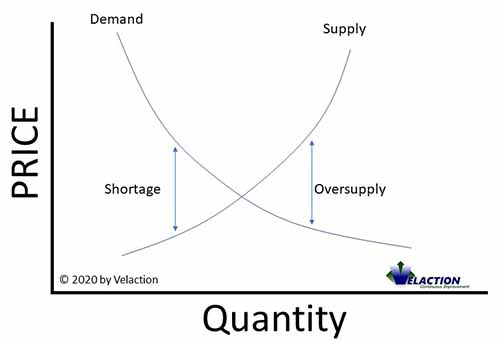Demand, Customer
Customer demand is the pull from a customer.
Don’t confuse customers saying they want to purchase something with actually buying something. There is a considerable fall-off between a customer admiring a product or service, and actually opening up her wallet.
Knowing your customer demand is critical to Lean operations. Customer demand plays a role in determining takt time, and in developing kanban quantities—both fundamentals of Lean.
Supply and Demand
Most people have at least some inkling of what supply and demand is on a macroeconomic scale. It basically says that there is a certain want for a product (demand) at each price. The supply side says the same. At each price, a certain number of companies will be willing to supply those products. Where they meet is called the equilibrium point.
The following chart is a visual representation of this concept. As you can imagine, at low prices, lots of people would want an item. At high prices, fewer people do.

Now, this is a compilation of the entire market. The point where the two lines cross is called the equilibrium point. It is the price at which suppliers will sell and buyers will buy the same amount. Obviously, below that price, buyers want more than suppliers will sell, creating a shortage. Above that price, suppliers would be more than willing to sell more than buyers want, creating oversupply.
The shape of this curve determines how a company sets its pricing. Selling more at too low of a price might lose money vs. selling less at a higher price. But the concept behind these curves drives those pricing decisions.
Now, the reality is that not all suppliers charge the same price, and not all buyers have the same price limits. The goal of suppliers is to capture the greatest number of the buyers willing to pay more.
Lean companies have the advantage of providing higher quality products faster, while costing the company less to do it. That means they can position the product differently, which shifts the demand curve, and lets them move the supply curve, as they can still be profitable with lower prices.
Movement along these lines is known as price elasticity of demand, or the price elasticity of supply. The slope of the line indicates how elastic the price is. Things like gasoline might be relatively inelastic. Small increases and decreases might not change how much people drive. Soft drinks might be a lot more elastic, as there are many alternatives available. Small changes in price can affect demand in a big way.
Demand Shifts
Occasionally, there will be some change to the demand you see. It might be seasonal, or some other form of cyclical business. It might be driven by some other factor (a vendor outside Yankee stadium sees demands spikes during home games). It might be a logical pattern (McDonald’s meal demand during lunch and dinner periods). In many cases, you can identify the driver of demand and be in a better position to make sure your capacity is matched up to your demand. This demand may be predictable, or it might vary in a seeming random pattern.
On the earlier chart, this change in demand would be shown by a lateral shift in the demand line. At all prices, people would be buying a different amount on a new line. This will also move the equilibrium point.
Dependent Demand
Some demand is generated in lockstep with the demand of another product and is known as dependent demand. As an example, new car sales drive a whole lot of dependent demand. Gasoline, tires, and air fresheners all are based on the number of cars on the road. Suppliers of raw materials for those cars are entirely at the mercy of their customers marketing efforts. They have very little influence on the demand of the end item they are supplying the part for.

There are a few things to consider regarding customer demand in a Lean company. While the concept of pull works, it is often limited to a specific range of customer demand. These small variations in demand mix can be handled by heijunka.
Larger changes in customer demand require things like Standard Work playbooks, or permanent changes in capacity.
Dealing with Demand Spikes
When your demand varies wildly, you have more of a challenge in satisfying your customer. Perceived demand spikes seem to happen more frequently in an office environment than in a production environment.
This is because many manufacturers are able to average out the demand their production areas see. They build to average demand, with a bit in a finished goods inventory. It smooths out the hills and valleys in demand for them and creates consistency. Manufacturing teams also have the opportunity to build ahead for demand surges. If they anticipate, for example, a big snow system coming in a few weeks, they can ramp up snow shovel production.
In the office, you are more likely to have customer facing jobs, which means there is opportunity to save work for later. You have to deal with bank customers when they are in the lobby, and answer phone calls when they are actually ringing. Take too long, and the phones go silent or the customers walk across the street to another bank.
Dealing with variable demand takes some creativity. It is much easier when the variation is predictable, such as fast food customer patterns. You can hire or reallocate extra help during meal periods. When demand is unpredictable…
Extended Content for this Section is available at academy.Velaction.com


0 Comments